Uninstall Amazon virus (Uninstall Instructions) - Sep 2017 updated
Amazon virus Removal Guide
Description of Amazon virus
Amazon virus operates in different shapes
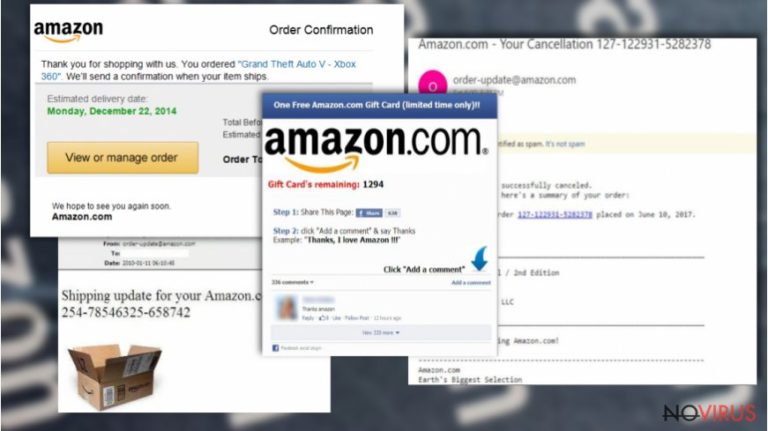
Amazon virus functions as malware which may come in different forms of a browser hijacker, malware or a trojan. It may also corrupt the device via a corrupted application.
It is necessary to note that the infection is not related to the online shop – Amazon – in any way. In fact, it benefits from its famous name to disguise its malevolent origin. It also tends to spread as a browser extension named as Amazon Assistant Smart Search engine, for instance.
Unfortunately, due to its different forms, Amazon virus removal requires different measures as well. In any case, it is highly recommended to scan the device with FortectIntego or Malwarebytes.
IT researchers spotted the first signs of the malware already in 2012. The campaign includes fake spam emails supposedly sent by Amazon support page.
Furthermore, similar phishing attacks technique only encourage other fraudsters to engage in a felony. Some of the malware samples target users’ sensitive information or meddle with registry or security app settings.
The diversity of scams
One of the most frequent includes sending forged emails about ‘cancelled order.’ Due to the popularity of Amazon shop, there is a high probability that a hoax email would reach a user, who, indeed, is waiting for the order to be delivered.
Alternative versions may attempt to deceive users with fake invoices or notifications about unsuccessful payments. There are also scam versions which try to persuade gullible into activating a fake verification code.
Other types of spam emails tempt you to open the attached file. Such email would deceive users that crucial information is placed in a .zip folder.
One must use the information within to proceed with the payment or order delivery. All in all, cyber villains do not cease astonishing the virtual community with more insidious hacking and deception strategies.
Therefore, the malware category keeps diversifying as it already acquires its alternative names “Amazon phishing email 2017” or “Amazon virus email 2017.” Now let us discuss a most prevalent sample of Amazon virus.
Locky virus scam. Last year Locky ransomware has made its name imprinted in the history of most destructive ransomware.
Unfortunately, it keeps terrifying users with new versions, Lukitus being one of them. In 2016, besides Facebook, Locky developers also assaulted Amazon community by bombarding them with fake emails which came from auto-shipping(@)amazon.com.
Auto-confirm[@]amazon-payments-support.co.uk scam. The subject ‘Your Amazon.com Order Has Dispatched [#random number]’, unfortunately, persuaded users into reading the email and extracting the content of a fake invoice email. Unfortunately, little did they know what menace they had activated.
Auto-confirm[@]amazon-payments-support.co.uk scam was set up to convince users to purchase goods at incredibly low prices. Certainly, discounts and giveaways always attract attention.
If you, after all, give in to the temptation to purchase a smart TV set or mobile device for a low price, sooner or later, you will sense the fraud as felons will ask you contact them outside Amazon platform and not some shady domain as auto-confirm[@]amazon-payments-support.co.uk. Further on, they might fool into paying additional fees for the commodity or even wheedle out credit card information.
Therefore, it is highly recommended to conduct purchases within Amazon platform and avoid performing any instructions if you suspect that the sender is not Amazon.
Amazon Prime scam. This type of felony attempts to wheedle out personal information such as credit card and email login credentials. Usually, such deception involves bombarding users with fake Amazon account verification emails.
By clicking on the link, victims are redirects to a forged website which imitates the original version. Unfortunately, entering the details in such website helps racketeers acquire your personal data. Note that such spam messages may come from the emails such as order-update@amazon.
Note that the emails may seem very persuasive, but you can look through the disguise by paying attention to these aspects:
- look for grammar and style mistakes, and typos
- verify the sender before opening an email supposedly sent by Amazon support group
- scan the attachment with a reliable anti-virus utility
Note that genuine Amazon support emails do not send you requirements about the necessity to verify your account unless you requested for a password reset or you have attempted to log in to your account successfully several times in a row. 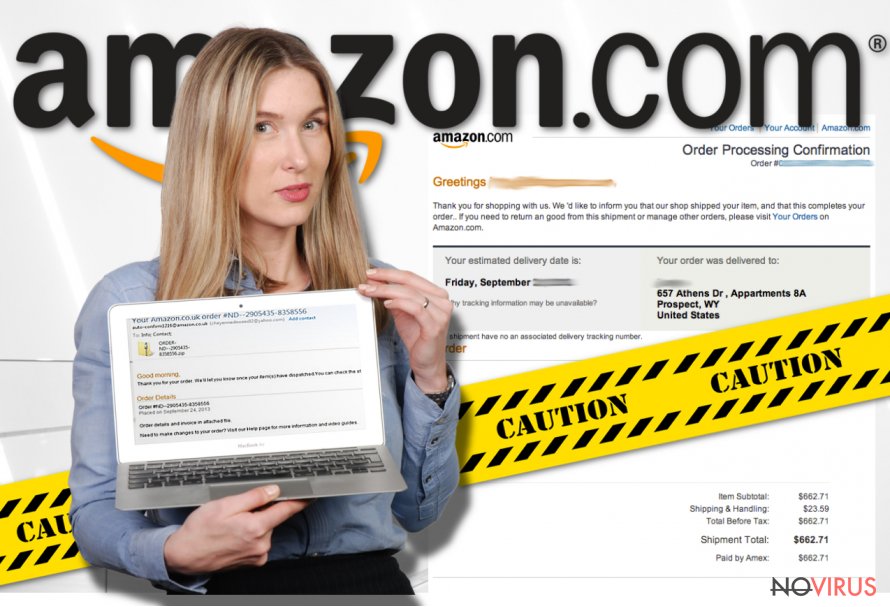
Detecting fraudulent emails
As discussed below, Amazon virus most likely comes in the form of spam emails. Additionally, beware pf the websites which pretend to be affiliated with Amazon and asks for your personal information.
Bear in mind the above-discussed tips to escape activating Amazon virus hijack. Some malware elimination software blocks spam emails and divert you from fake websites. Finally, your vigilance also plays a significant role in maintaining cyber security.
Eliminate Amazon virus and ensure the safety of your data
In case you suspect that your browser was compromised or your inbox is overcrowded with emails supposedly sent by Amazon, they might be the primary signs that it is time to remove Amazon virus.
You can do so with the assistance of malware elimination utility. If you got infected with ransomware via a fake Amazon email attachment, then you will have to reboot the system in Safe Mode and launch the updated malware elimination utility.
In case you are dealing with the browser version of Amazon malware, besides scanning the device, delete its web elements and extensions. Resetting browser settings will also contribute to Amazon virus removal. You can find this function under the Settingsof your browser.
You may remove virus damage with a help of FortectIntego. SpyHunter 5Combo Cleaner and Malwarebytes are recommended to detect potentially unwanted programs and viruses with all their files and registry entries that are related to them.
Getting rid of Amazon virus. Follow these steps
In-depth guide for the Amazon elimination
Safe Mode will grant you partial access to the system and, likewise, you will be able to run the security tool and eliminate Amazon virus.
Important! →
The elimination guide can appear too difficult if you are not tech-savvy. It requires some knowledge of computer processes since it includes system changes that need to be performed correctly. You need to take steps carefully and follow the guide avoiding any issues created due to improper setting changes. Automatic methods might suit you better if you find the guide too difficult.
Step 1. Launch Safe Mode with Networking
Safe Mode environment offers better results of manual virus removal
Windows 7 / Vista / XP
- Go to Start.
- Choose Shutdown, then Restart, and OK.
- When your computer boots, start pressing the F8 button (if that does not work, try F2, F12, Del, etc. – it all depends on your motherboard model) a few times until you see the Advanced Boot Options window.
- Select Safe Mode with Networking from the list.
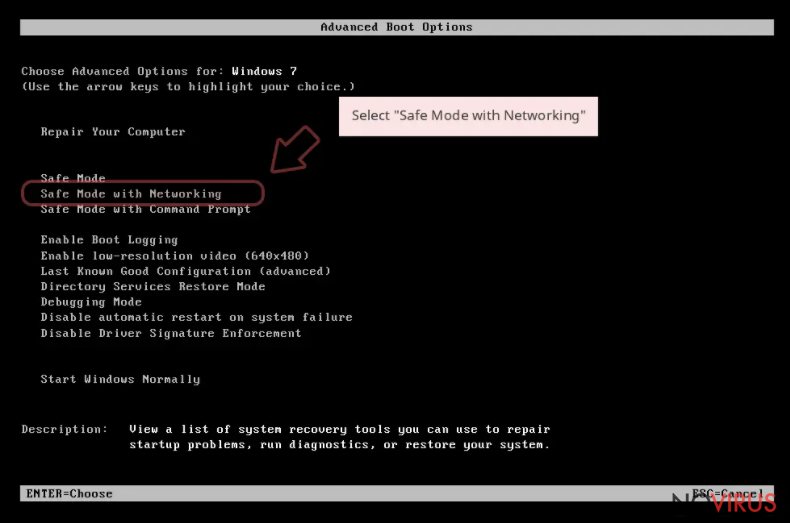
Windows 10 / Windows 8
- Right-click the Start button and choose Settings.
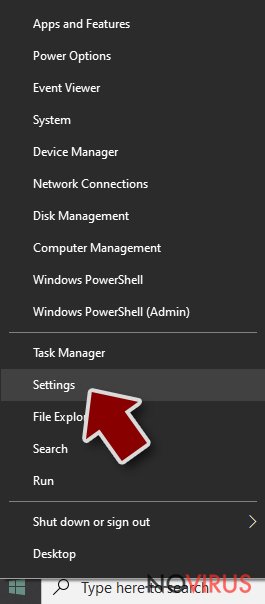
- Scroll down to find Update & Security.
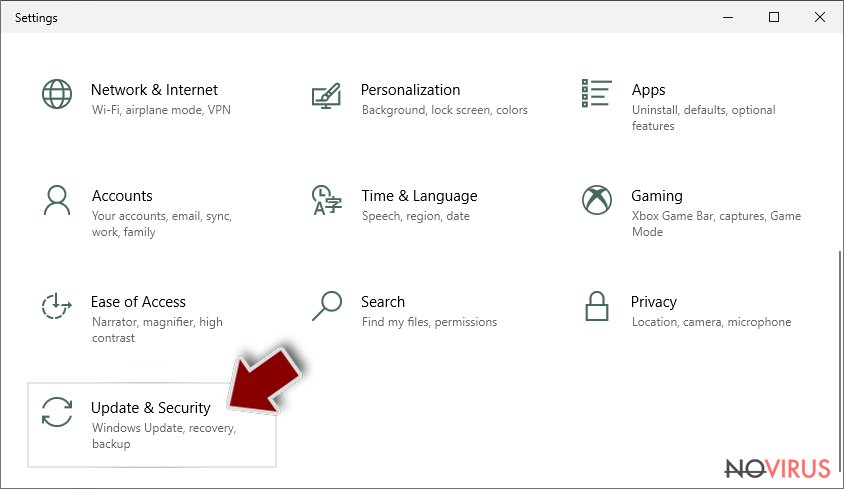
- On the left, pick Recovery.
- Scroll to find Advanced Startup section.
- Click Restart now.
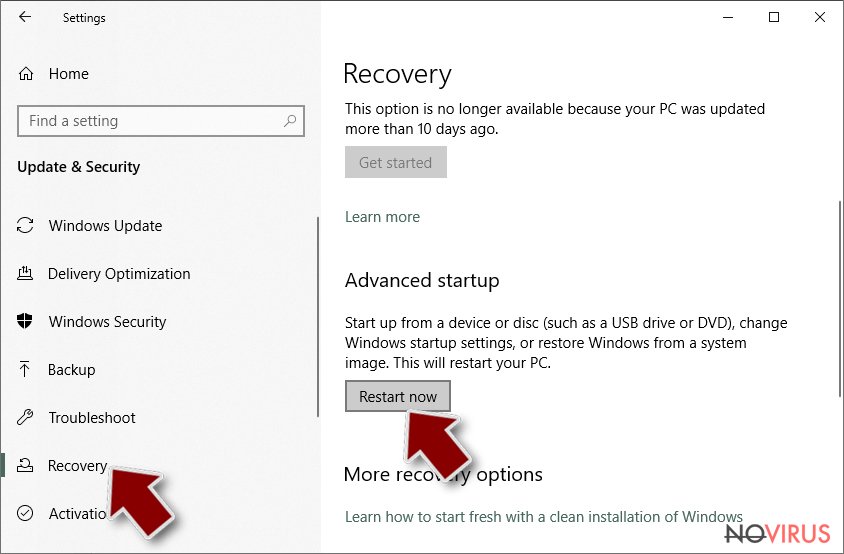
- Choose Troubleshoot.
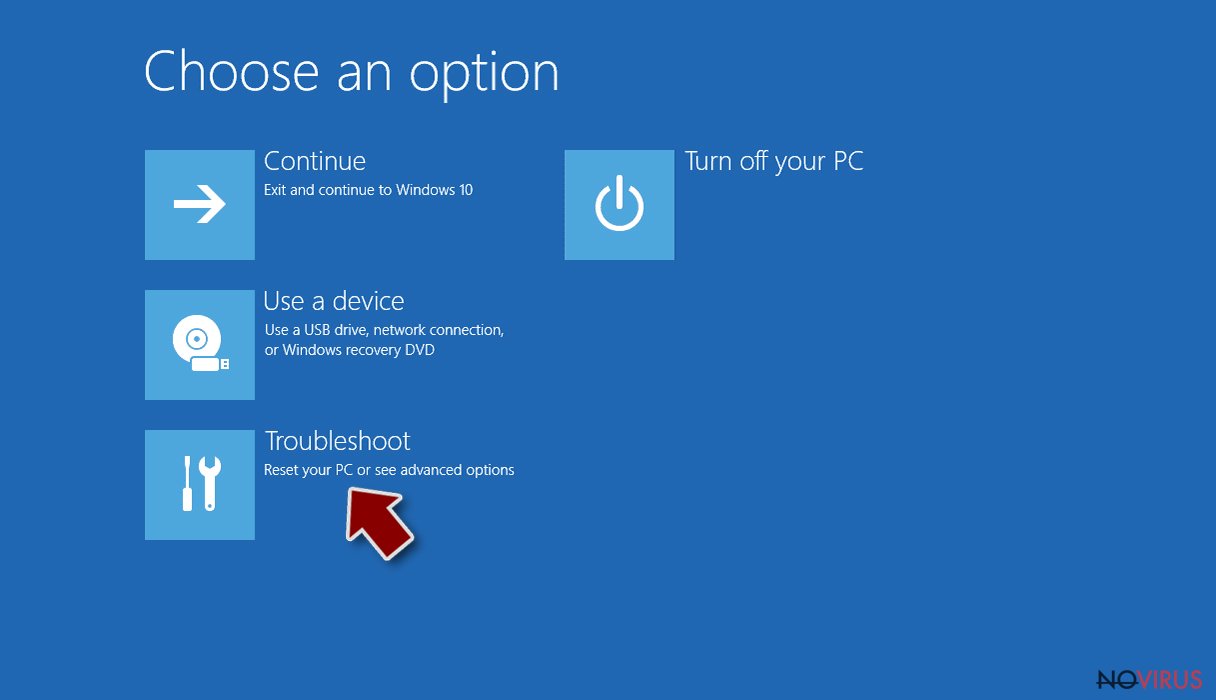
- Go to Advanced options.
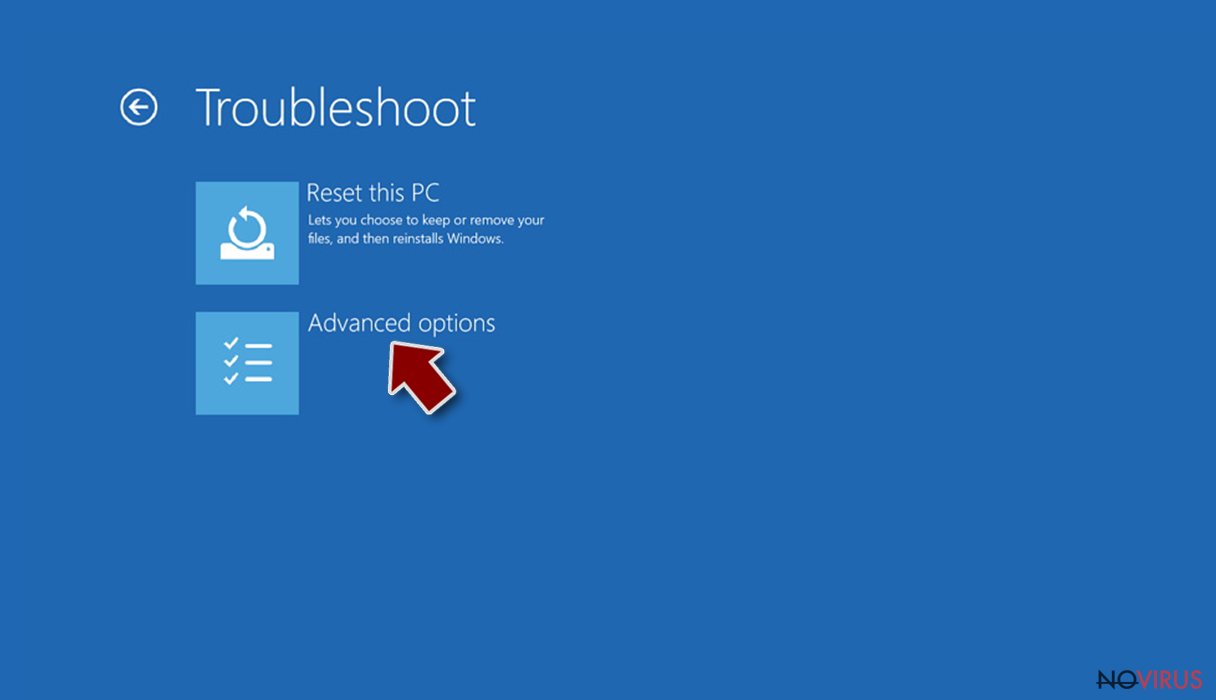
- Select Startup Settings.
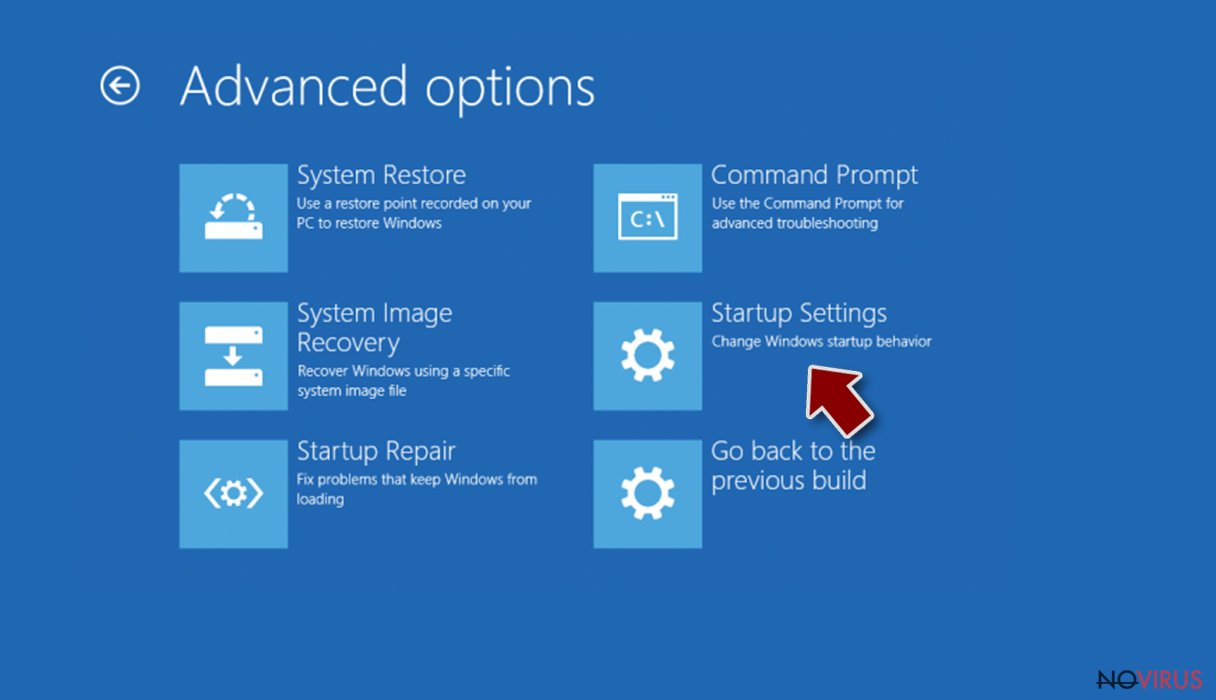
- Press Restart.
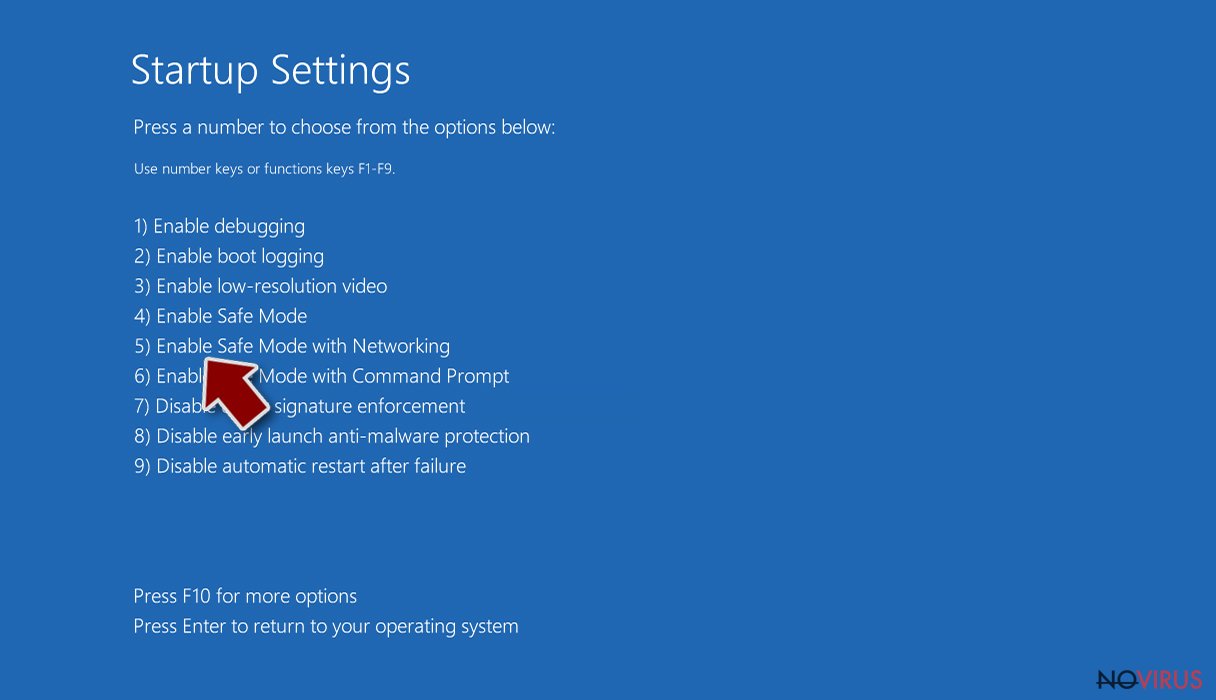
- Choose 5) Enable Safe Mode with Networking.
Step 2. End questionable processes
You can rely on Windows Task Manager that finds all the random processes in the background. When the intruder is triggering any processes, you can shut them down:
- Press Ctrl + Shift + Esc keys to open Windows Task Manager.
- Click on More details.
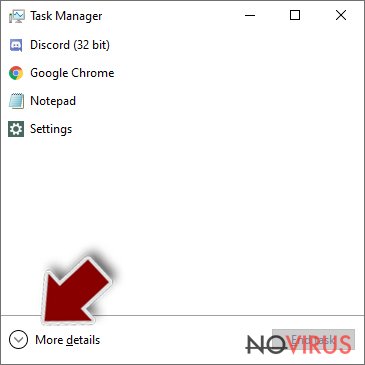
- Scroll down to Background processes.
- Look for anything suspicious.
- Right-click and select Open file location.

- Go back to the Process tab, right-click and pick End Task.
- Delete the contents of the malicious folder.
Step 3. Check the program in Startup
- Press Ctrl + Shift + Esc on your keyboard again.
- Go to the Startup tab.
- Right-click on the suspicious app and pick Disable.
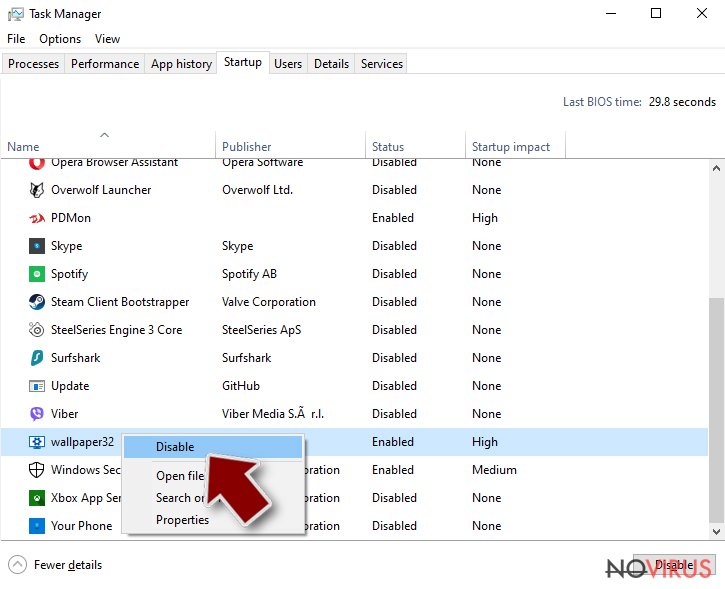
Step 4. Find and eliminate virus files
Data related to the infection can be hidden in various places. Follow the steps and you can find them:
- Type in Disk Cleanup in Windows search and press Enter.
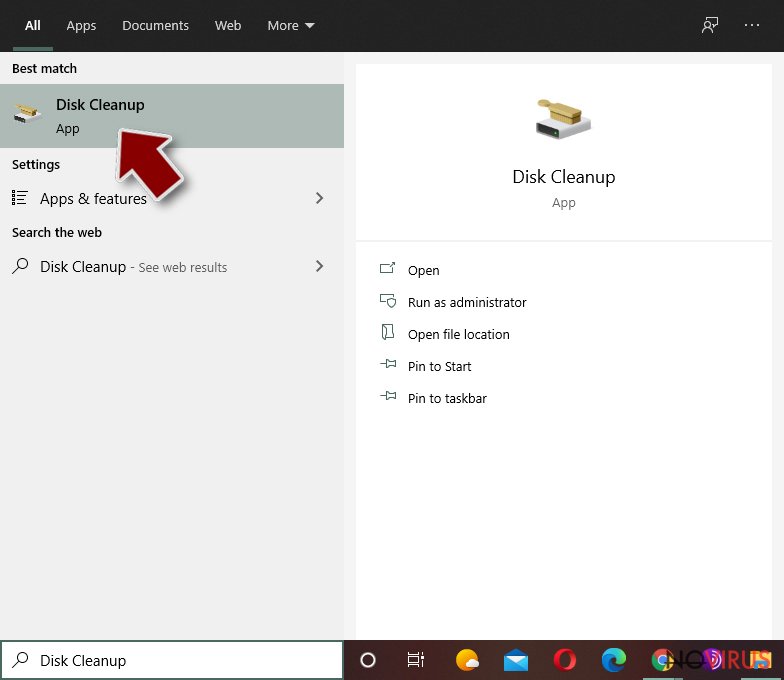
- Select the drive (C: is your main drive by default and is likely to be the one that has malicious files in) you want to clean.
- Scroll through the Files to delete and select the following:
Temporary Internet Files
Downloads
Recycle Bin
Temporary files - Pick Clean up system files.
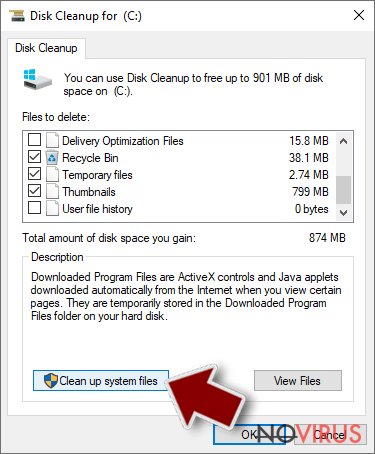
- You can also look for other malicious files hidden in the following folders (type these entries in Windows Search and press Enter):
%AppData%
%LocalAppData%
%ProgramData%
%WinDir%
After you are finished, reboot the PC in normal mode.
Eliminate Amazon using System Restore
In case the first method is not convenient to you, you may perform System Restore.
-
Step 1: Restart your computer in Safe Mode with Command Prompt
Windows 7 / Vista / XP- Go to Start → Shutdown → Restart → OK.
- As soon as your computer starts, start pressing F8 key repeatedly before the Windows logo shows up.
-
Choose Command Prompt from the list

Windows 10 / Windows 8- Click on the Power button at the Windows login screen, and then press and hold Shift key on your keyboard. Then click Restart.
- Then select Troubleshoot → Advanced options → Startup Settings and click Restart.
-
Once your computer starts, select Enable Safe Mode with Command Prompt from the list of options in Startup Settings.

-
Step 2: Perform a system restore to recover files and settings
-
When the Command Prompt window appears, type in cd restore and press Enter.

-
Then type rstrui.exe and hit Enter..

-
In a new window that shows up, click the Next button and choose a restore point that was created before the infiltration of Amazon and then click on the Next button again.


-
To start system restore, click Yes.

-
When the Command Prompt window appears, type in cd restore and press Enter.
Bonus: Restore your files
Using the tutorial provided above you should be able to eliminate Amazon from the infected device. novirus.uk team has also prepared an in-depth data recovery guide which you will also find above.If you have opened the attachment of earlier-mentioned Locky virus scam or another ransomware, your files must have been already encoded. In order to decode the data, it would be best to use backups or the genuine free decrypter (created by IT experts) specific for the malware. If there is no such software created, look up for alternative options. Some of them are discussed below.
There are a couple of methods you can apply to recover data encrypted by Amazon:
Data Recovery Pro solution
This tool is designed to restore files affected by system failure. Nonetheless, it might come in handy in recovering files affected by a file-encrypting virus.
- Download Data Recovery Pro;
- Install Data Recovery on your computer following the steps indicated in the software’s Setup;
- Run the program to scan your device for the data encrypted by Amazon ransomware;
- Recover the data.
What is Windows Previous Versions function?
If System Restore has been previously enabled, you might succeed in restoring files. Note that this method takes more time.
- Right-click on the encrypted document you want to recover;
- Click “Properties” and navigate to “Previous versions” tab;
- In the “Folder versions” section look for the available file copies. Choose the desired version and press “Restore”.
The usefulness of Shadow Explorer
The utility uses shadow volume copies to create the copies of your files. It is one of the last resorts in recovering data.
- Download Shadow Explorer (http://shadowexplorer.com/);
- Install Shadow Explorer on your computer following the instructions in the software’s Setup Wizard;
- Run the program. Navigate to the menu on the top-left corner and select a disk containing your encrypted files. Look through the available folders;
- When you find the folder you want to recover, right-click it and select “Export”. Also, choose where the recovered data will be stored.
Even if you have completed all the steps above, we still strongly recommend you to scan your computer system with a powerful anti-malware software. It is advisable to do that because an automatic malware removal tool can detect and delete all remains of Amazon, for instance, its registry keys. The anti-malware program can help you to easily detect and eliminate possibly dangerous software and malicious viruses in an easy way. You can use any of our top-rated malware removal programs: FortectIntego, SpyHunter 5Combo Cleaner or Malwarebytes.
How to prevent from getting malware
A proper web browser and VPN tool can guarantee better safety
As online spying becomes an increasing problem, people are becoming more interested in how to protect their privacy. One way to increase your online security is to choose the most secure and private web browser. But if you want complete anonymity and security when surfing the web, you need Private Internet Access VPN service. This tool successfully reroutes traffic across different servers, so your IP address and location remain protected. It is also important that this tool is based on a strict no-log policy, so no data is collected and cannot be leaked or made available to first or third parties. If you want to feel safe on the internet, a combination of a secure web browser and a Private Internet Access VPN will help you.
Reduce the threat of viruses by backing up your data
Due to their own careless behavior, computer users can suffer various losses caused by cyber infections. Viruses can affect the functionality of the software or directly corrupt data on your system by encrypting it. These problems can disrupt the system and cause you to lose personal data permanently. There is no such threat if you have the latest backups, as you can easily recover lost data and get back to work.
It is recommended to update the backups in parallel each time the system is modified. This way, you will be able to access the latest saved data after an unexpected virus attack or system failure. By having the latest copies of important documents and projects, you will avoid serious inconveniences. File backups are especially useful if malware attacks your system unexpectedly. We recommend using the Data Recovery Pro program to restore the system.







